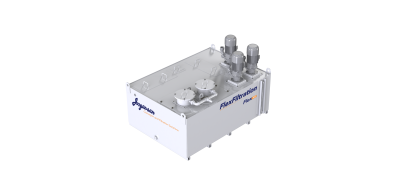
Further expanding the adaptability of its industry leading FlexFiltration, Jorgensen Conveyors and Filtration has launched new Flex B and Flex C versions for that modular coolant filtration system. The Flex B uses bag filtration, while Flex C incorporates a cylindrical/hydrocyclone filter. Both versions are built on the modular FlexFiltration design and allow shops to easily adapt their filtration to changing jobs, materials and production needs.
Jorgensen’s FlexFiltration system combines pre-engineered modules to tackle difficult coolant filtration applications. It efficiently removes fine chips and grinding sludge to achieve coolant clarity down to 10 microns or less. FlexFiltration provides coolant filtration for a variety of difficult materials including cast iron, steel, aluminum, plastic and composite materials, giving end users and OEMs alike the ability to standardize their coolant filtration process on a platform that is modular and adaptable.
The Flex B and Flex C join Jorgensen’s existing Flex G gravity filter version. Flex B provides the same flow rates as Flex G – 30, 60 and 90 gpm – and filtration down to 10 microns for most applications. As its main filtration method, bag filters make the Flex B a cost-effective method for coolant and cutting fluid filtration and ideal for CNC machine tool applications involving either single machines or centralized coolant systems.
Jorgensen’s engineers can easily incorporate bag filters into new or pre-existing coolant systems. Doing so serves as a quick, low-cost solution for removing small chips, grinding swarf and other particulate down to 10 micron nominal.
Like Flex B, Flex C also provides the same flow rates as Flex G – 30, 60 and 90 gpm – and filtration down to 10 microns at a very high efficiency.
In operation, contaminated CNC coolant enters the cyclonic filter at a high velocity through the inlet opening. The velocity of the liquid increases as it swirls downward inside the conical separating chamber. Then, solid contaminants are thrown against the walls of the chamber and forced to the bottom by centrifugal force. These solids are then discharged through a nozzle at the bottom of the filter, achieving high separation efficiency without filter media consumption.
As the whirling cleaned liquid approaches the bottom, it is unable to exit the restricted discharge nozzle. As a result, it reverses direction, forms an inner vortex and seeks the clean liquid outlet at the top of the filter. Using this hydrocyclone filtration as its main filtration method, Flex C is economically and environmentally friendly as there are no disposable medias to worry about. Jorgensen offers hydrocyclone filters in a variety of sizes to fit the volume and desired coolant clarity.
Contact Details
Related Glossary Terms
- computer numerical control ( CNC)
computer numerical control ( CNC)
Microprocessor-based controller dedicated to a machine tool that permits the creation or modification of parts. Programmed numerical control activates the machine’s servos and spindle drives and controls the various machining operations. See DNC, direct numerical control; NC, numerical control.
- coolant
coolant
Fluid that reduces temperature buildup at the tool/workpiece interface during machining. Normally takes the form of a liquid such as soluble or chemical mixtures (semisynthetic, synthetic) but can be pressurized air or other gas. Because of water’s ability to absorb great quantities of heat, it is widely used as a coolant and vehicle for various cutting compounds, with the water-to-compound ratio varying with the machining task. See cutting fluid; semisynthetic cutting fluid; soluble-oil cutting fluid; synthetic cutting fluid.
- cutting fluid
cutting fluid
Liquid used to improve workpiece machinability, enhance tool life, flush out chips and machining debris, and cool the workpiece and tool. Three basic types are: straight oils; soluble oils, which emulsify in water; and synthetic fluids, which are water-based chemical solutions having no oil. See coolant; semisynthetic cutting fluid; soluble-oil cutting fluid; synthetic cutting fluid.
- grinding
grinding
Machining operation in which material is removed from the workpiece by a powered abrasive wheel, stone, belt, paste, sheet, compound, slurry, etc. Takes various forms: surface grinding (creates flat and/or squared surfaces); cylindrical grinding (for external cylindrical and tapered shapes, fillets, undercuts, etc.); centerless grinding; chamfering; thread and form grinding; tool and cutter grinding; offhand grinding; lapping and polishing (grinding with extremely fine grits to create ultrasmooth surfaces); honing; and disc grinding.
- micron
micron
Measure of length that is equal to one-millionth of a meter.
- swarf
swarf
Metal fines and grinding wheel particles generated during grinding.

